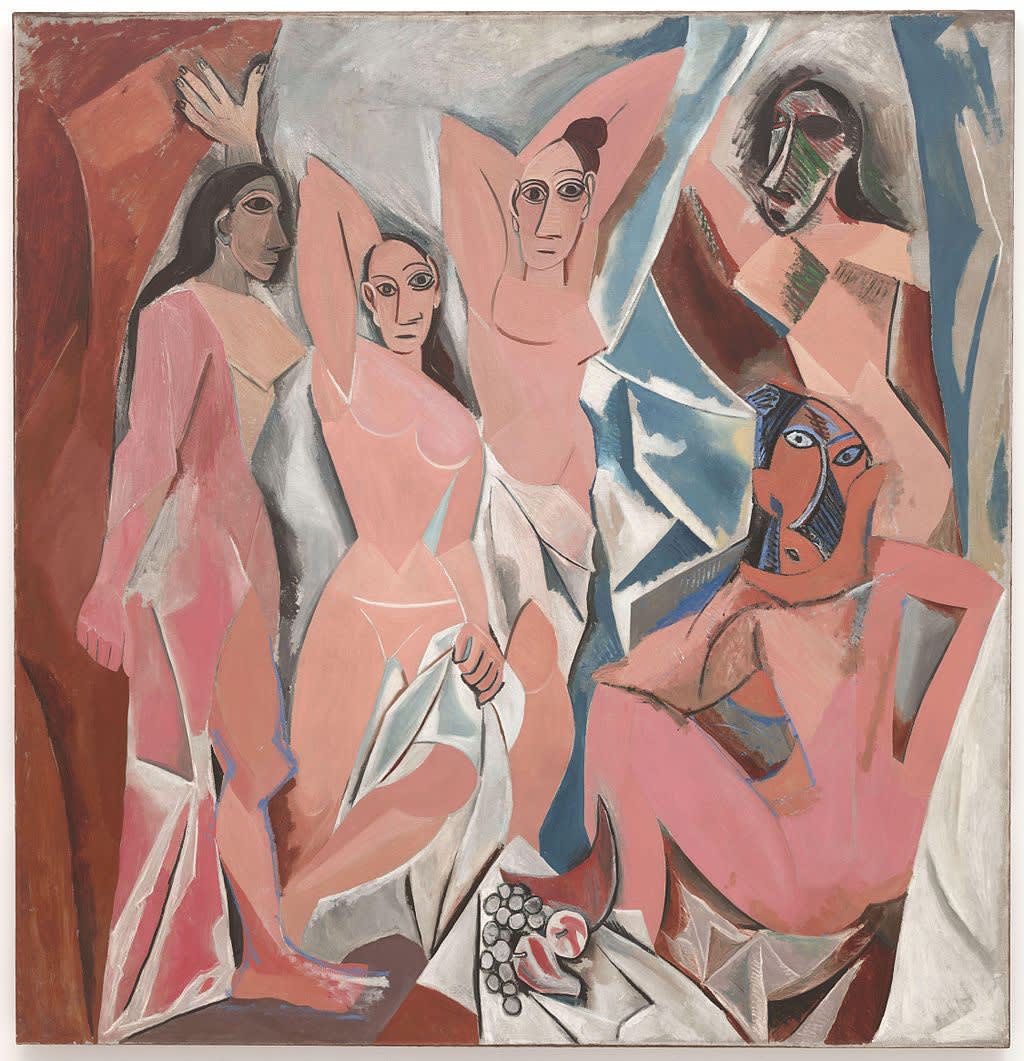Pablo Picasso's Les Demoiselles d'Avignon, 1907, oil on canvas, 243.9 x 233.7 cm (The Museum of Modern Art, New York) Speakers: Dr. Beth Harris and Dr. Steven Zucker
Les Demoiselles d'Avignon (The Young Ladies of Avignon, originally titled The Brothel of Avignon)[2] is a large oil painting created in 1907 by the Spanish artist Pablo Picasso. The work, part of the permanent collection of the Museum of Modern Art, portrays five nude female prostitutes in a brothel on Carrer d'Avinyó, a street in Barcelona, Spain. Each figure is depicted in a disconcerting confrontational manner and none is conventionally feminine. The women appear slightly menacing and are rendered with angular and disjointed body shapes. The figure on the left exhibits facial features and dress of Egyptian or southern Asian style. The two adjacent figures are shown in the Iberian style of Picasso's native Spain, while the two on the right are shown with African mask-like features. The ethnic primitivism evoked in these masks, according to Picasso, moved him to "liberate an utterly original artistic style of compelling, even savage force.
In this adaptation of primitivism and abandonment of perspective in favor of a flat, two-dimensional picture plane, Picasso makes a radical departure from traditional European painting. This proto-cubist work is widely considered to be seminal in the early development of both cubism and modern art.
Les Demoiselles was revolutionary and controversial and led to widespread anger and disagreement, even amongst the painter's closest associates and friends. Matisse considered the work something of a bad joke yet indirectly reacted to it in his 1908 Bathers with a Turtle. Georges Braque too initially disliked the painting yet perhaps more than anyone else, studied the work in great detail. His subsequent friendship and collaboration with Picasso led to the cubist revolution. Its resemblance to Cézanne's The Bathers, Paul Gauguin's statue Oviri and El Greco's Opening of the Fifth Seal has been widely discussed by later critics.
At the time of its first exhibition in 1916, the painting was deemed immoral. The work, painted in Picasso's studio in the Bateau-Lavoir in Montmartre, Paris, was seen publicly for the first time at the Salon d'Antin in July 1916, at an exhibition organized by the poet André Salmon. It was at this exhibition that Salmon (who had previously titled the painting in 1912 Le bordel philosophique) renamed the work its current, less scandalous title, Les Demoiselles d'Avignon, instead of the title originally chosen by Picasso, Le Bordel d'Avignon. Picasso, who always referred to it as mon bordel ("my brothel"), or Le Bordel d'Avignon,never liked Salmon's title and would have instead preferred the bowdlerization Las chicas de Avignon ("The Girls of Avignon").
Movement: Proto-Cubism
Dimensions: 243.9 cm × 233.7 cm (96 in × 92 in)
Location: Museum of Modern Art. Acquired through the Lillie P. Bliss Bequest, New York City

RELATED WORKS:
Subscribe and select your communication preferences here: http://eepurl.com/g2ts8v
- Art Education (Learn about art)
- Art proposals and opportunities
- Gallery Events (Invitations to the gallery shows, exhibitions, gallery house, other)
- External Events (Museums, Galleries visits, other events)
- Newsletter (Monthly)
- Last minute plans
-
Recent posts
- Juan Muñoz Exhibition October 14, 2025
- INTRODUCTION TO CONTEMPORARY ART November 25, 2024
- Learn to Paint Like a Pro in London– Your Artistic Journey Starts Here! November 25, 2024
- Explore Contemporary Art in Milan: Gallery Tours and Hidden Gems November 15, 2024
- Explore London's Contemporary Art Scene with Our Gallery Tours November 15, 2024
